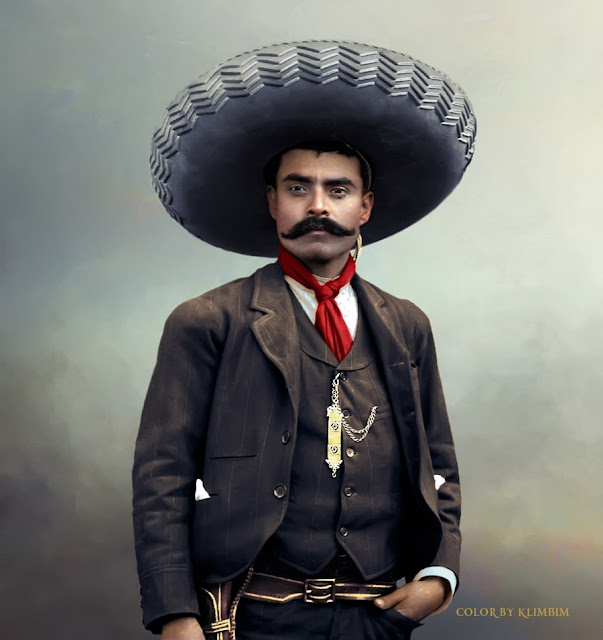ZAPATA OF MEXICO - PETER E NEWELL
Everyone has at least heard of Emiliano Zapata and Pancho Villa, I presume? If only from a slew of cowboy films where they and the Mexican Revolution are a backdrop to the main story? If not, then why not? If yes, then you might wonder what significance they have to the modern day world? Or if you know of the Zapatista slogan 'Tierra y Libertad' - 'Land and Liberty' - you might wonder how it might be relevant to a densely-packed urban population living in any of Britain's major conurbations where the closest a lot of people get to land is a window box on a tower block balcony? And of course, you wouldn't be wrong to wonder because Emiliano Zapata and the Mexican Revolution of 1910 do indeed appear to be a world away from the modern day world. But then on closer inspection and examination, however, they might actually be a lot closer than you think?

In January 1994, under the guidance of Subcommandante Insurgente Marcos, the indigenous people of Chiapas in Mexico declared independence of the Mexican State, creating an autonomous zone that is still in existence to this day. The indigenous people declared themselves to be Zapatistas, named after Emiliano Zapata from seeing themselves as his natural ideological heirs. They aligned themselves with anti-neoliberal sentiments and actions gaining traction at that time, recognising as natural allies the huge swathe of people around the world who were also questioning and physically challenging the concurrent global economic system.
A trade deal going by name of The North American Free Trade Agreement (NAFTA) had been struck between Mexico, America and Canada and it was going to leave the peasant land workers of Mexico in a very much worse off position to that which they were already in. It was this that instigated the people of Chiapas to not only reject the Mexican State but to also declare war against it. All driven by the confidence and belief that rather than a world of exploitation being thrust upon them, another world was possible.
As any would-be revolutionary should know, taking on the full military might of any State power is commendable but at the same time potentially foolhardy or even suicidal which is why Subcommandante Marcos and the Zapatistas of 1994 not only looked to Emiliano Zapata for inspiration but also for tactics.
"Amigos! It is better to die on your feet than to live on your knees," Zapata had once famously declared "The land free, free for all, without overseers and without masters, that is the cry of the revolution."
And so with these words echoing down from the past along with an additional cry of 'Basta!' (Enough!) the Zapatistas of 1994 armed only with machetes, clubs and a few guns launched their attack upon the Mexican State.
Emiliano Zapata had understood that sudden, hard, merciless attack is the best form of defence and that formal battles with the Mexican Army should be avoided unless victory was fairly certain, thereby denying the enemy the opportunity to destroy them at one blow. The Zapatistas were more an insurgent people than an army but were instead masters of guerrilla warfare. They laid traps and ambushes, cut supply lines, took small towns by storm, destroyed the smaller enemy units and harassed the larger ones. These tactics completely disconcerted their enemy who could never put their firepower into effective use. If the Mexican Army advanced with a large force, they never found anyone to fight and if they divided their forces they exposed themselves to destruction in ambushes and assaults.
Just as importantly, Zapata also understood the power of the word and that the written word in particular was also a weapon. Subsequently, circulars, decrees and manifestos would pour forth from the Zapatista headquarters. For Zapata, a printing press was just as valuable as a gun.
These are the lessons learned by Subcommandante Marcos in regard to the Mexican Revolution of 1910 though by 1994 there was of course also the Internet to be used as well, enabling therefore effective global communication to all fellow travellers and supporters. And vice versa.
Zapata Of Mexico by Peter E Newell is the sprawling, rolling story of Emiliano Zapata and how he came to symbolise unmitigated and unrepentant revolutionary zeal. It's the story of a man of great principle who could not be bought out or brought down by concessions or the lure of wealth and luxury. A man who was never interested in the seeking and gaining of power but in only the destruction of it. A man who still to this day symbolises a purity of intent that due to its very simplicity is at odds with everything that the modern day world of global economic capitalist power represents. A man who rather than trying to impose his will upon a people sought only to serve and protect that peoples' will.
Peter E Newell's book is not an easy read by any means as it's often difficult to keep up with the gamut of characters and place names stemming from how incredibly well researched it is. It is, however, an invaluable book and a useful gateway into the history of Mexico and the meaning of what it is to be a revolutionary in a world of exploitation, reactionary politics and compliance to the idea of greed being an inherent condition of human nature.
John Serpico



No comments:
Post a Comment